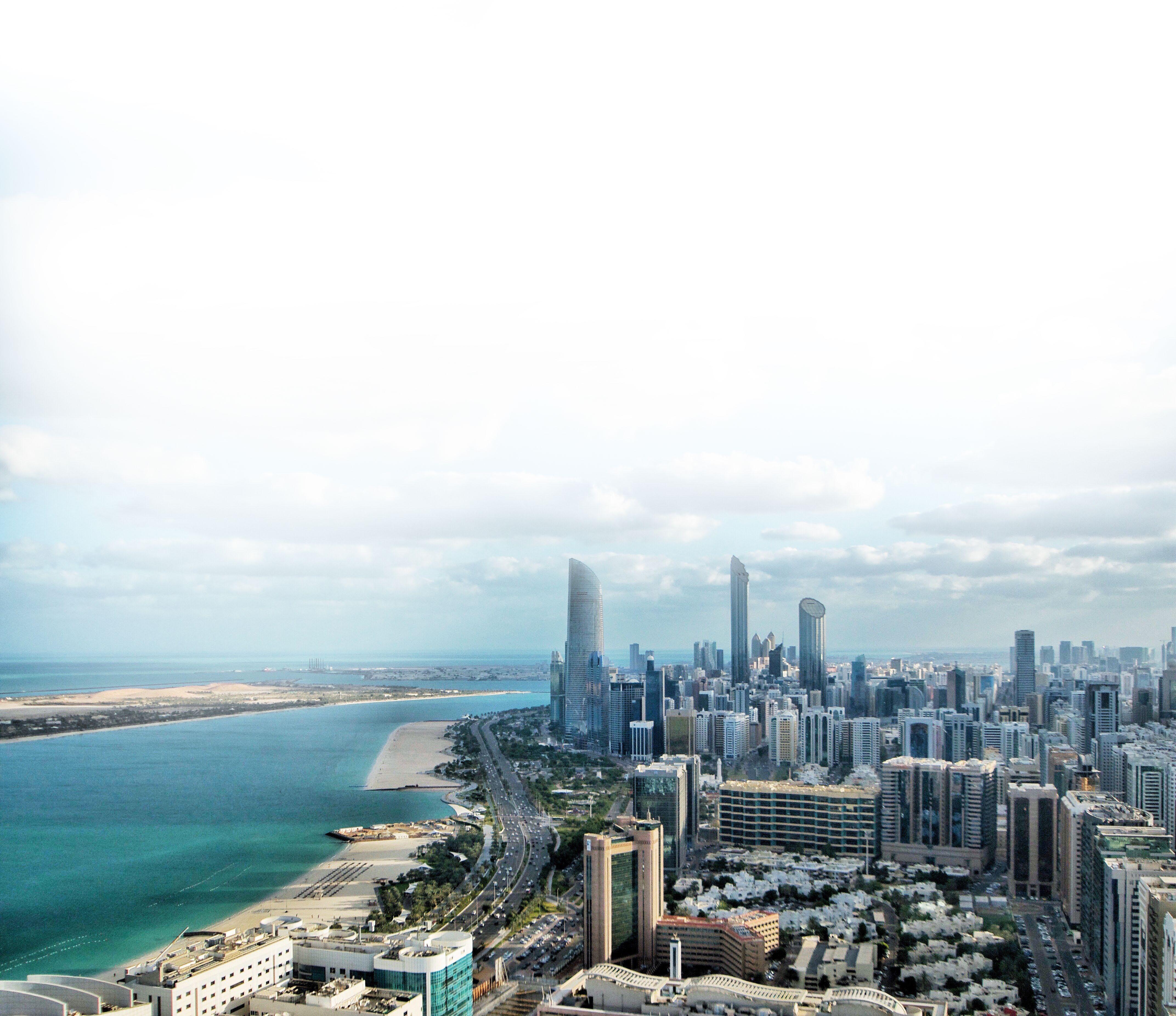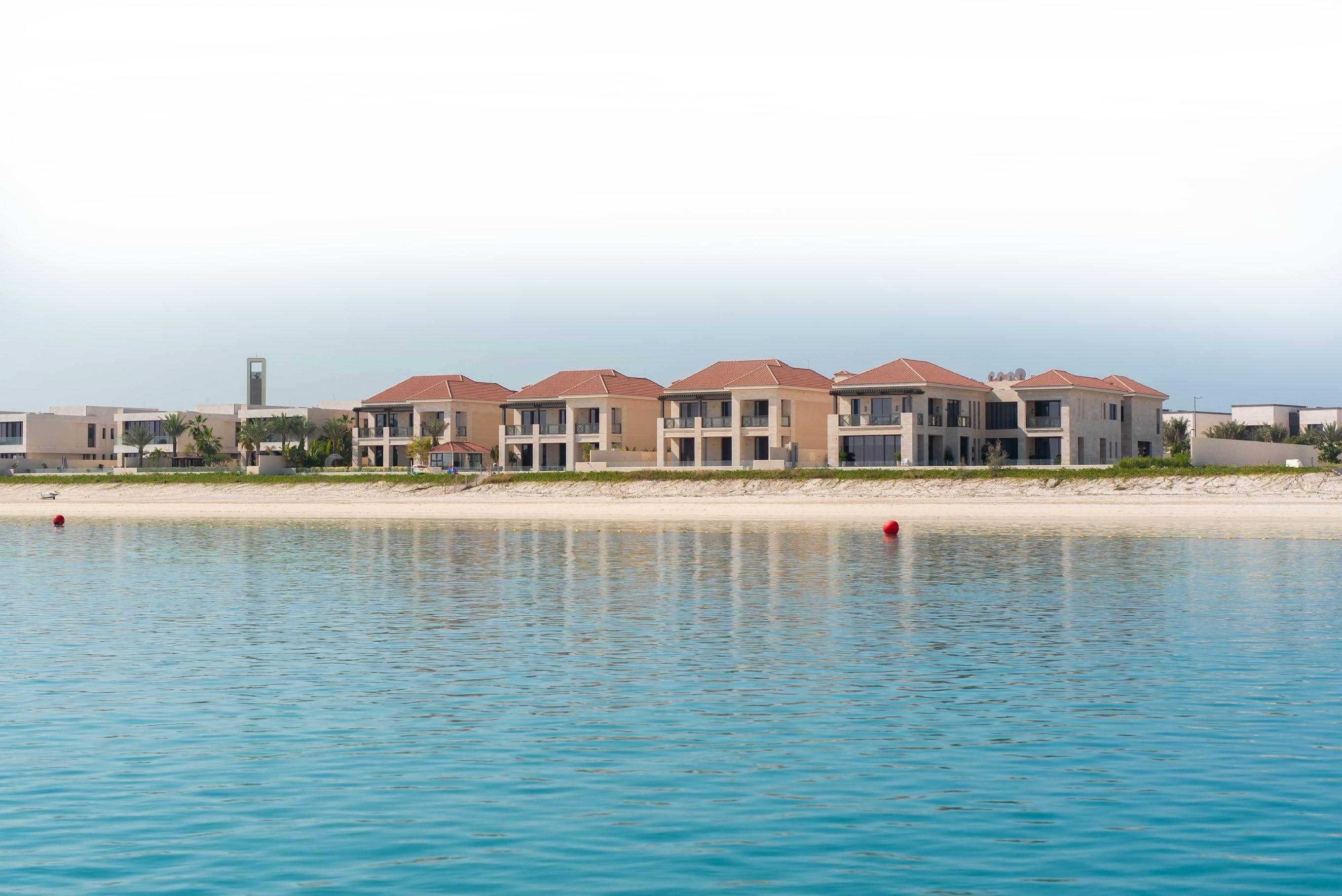

Abu Dhabi Residential Market Performance
Q3 2025





Macroeconomic Overview and Outlook
The Central Bank of the United Arab Emirates revised its 2025 GDP forecast upward from 4.4% to 4.9% reflecting stronger than expected economic momentum. Similarly, the International Monetary Fund (IMF) raised its projection for Abu Dhabi, forecasting 6% growth supported by increased oil production and steady expansion in non-oil sectors, particularly services and real estate. This growth aligns with Abu Dhabi Vision 2030, which targets a 64% non-oil share of GDP by 2030. According to the latest data from the Statistics Centre Abu Dhabi (SCAD), the Emirate’s non-oil economy has already reached 56.5% which shows clear progress toward this long-term goal.
Abu Dhabi’s sovereign investment ecosystem further reinforces this trajectory. Abu Dhabi Developmental Holding Company (ADQ) and Mubadala Investment Company (Mubadala) continue to drive domestic economic development by deploying capital into priority sectors, while the Abu Dhabi Investment Office (ADIO) plays a pivotal role in attracting foreign direct investment by facilitating business setup and supporting global companies establishing a presence in the Emirate. Together, these institutions continue to strengthen Abu Dhabi’s economic foundations and increase investor confidence.

Looking ahead, Abu Dhabi’s economic outlook remains firmly positive. Growth is expected to be supported by ongoing diversification initiatives, major infrastructure development, and a favourable regulatory environment. Foreign investment is also expected to remain strong, supported by policy stability, transparent governance, and a sophisticated business ecosystem. At the same time, population growth driven by job creation and strong talent inflows will reinforce demand across key sectors including hospitality, retail, education, and particularly real estate. Taken together, these forces are set to maintain economic momentum and strengthen long-term market resilience across the Emirate.
Sales Transactions
Abu Dhabi’s residential market continued to rise in the third quarter of 2025, with overall transaction volumes in Abu Dhabi City reaching their highest level on record, supported by robust demand from both end-users and investors. Growth was driven by strong activity acr the off-plan and ready segments, though the off-plan market remained the main catalyst behind the surge.
The off-plan segment recorded approximately 4,700 transactions, a 106.5% year-on-year increase, fuelled by a wave of new project launch es in Q3 2025, which was the highest quarterly total so far this year. Meanwhile, the ready segment registered around 1,700 sal tions, up 31.9% compared to Q3 2024, reflecting strong demand for completed homes even as the off-plan market gained momentum.
Abu Dhabi City Unit Sales Transactions - By Volume


Source: Quanta, Cavendish Maxwell

Source: Quanta, Cavendish Maxwell

Sales Transactions by Property Type: Apartments

Apartments continued to dominate Abu Dhabi City's residential unit sales market in Q3 2025, with their market share rising to 78.8%, up from 62.1% in Q3 2024. The off-plan segment was the primary driver of this growth, recording approximately 3,800 transactions, an increase of 182.2% compared to the same period last year. Ready apartment sales also performed well, reaching around 1,300 transactions, up 43.2% year-on-year. The strong performance of the apartment segment highlighted the continued appeal of the city’s apartment market, driven not only by investor interest but also by strong demand from young professionals and smaller families.
Abu Dhabi City Apartment Transactions - By Volume
Source: Quanta, Cavendish Maxwell
*Apartment sales data excludes transactions involving duplexes and penthouses.

Property Type: Villas and Townhouses
Although transaction activity for villas and townhouses recorded an uptick, growth lagged behind that of apartments. Around 1,400 villa and townhouse transactions were registered during the quarter, marking an increase of 8.3% quarter-on-quarter and 0.3% year-on-year. The relatively subdued growth was primarily due to the limited number of new launches within the segment, which limited the number of units available for sale. This channelled buyer interest towards the apartment segment.
Abu Dhabi City Villa/Townhouse Transactions - By Volume

Source: Quanta, Cavendish Maxwell
Sales Transactions by District
Apartment sales activity was heavily concentrated in Al Reem Island, Yas Island, Fahid Island and Al Saadiyat Island; together, these districts accounted for 62.3% of total residential unit transactions. Meanwhile, Al Bahyah and Yas Island led villa and townhouse sales activity in Q3 2025.
Abu Dhabi City Transactions by Volume: Top 5 Districts – Apartments

Abu Dhabi City Sales Transactions by Volume: Top 5 Districts – Villas and Townhouses
Al Bahyah
Al Reem Island
Hidayriyyat
City
Source: Quanta, Cavendish Maxwell
Source: Quanta, Cavendish Maxwell
Existing and Future Supply
Around 2,700 residential units were delivered in Abu Dhabi City during the first three quarters of 2025, with a further 8,400 units scheduled for completion in Q4. Based on recent handover trends, actual deliveries may fall short of initial projections. This staggered pattern of completions has been typical for the Emirate and usually helps the market absorb new supply steadily, preventing sudden increases in available stock.
At the same time, demand fundamentals remain strong despite the active development pipeline. Ongoing population growth and the growing appeal of newer, master-planned communities continue to support absorption, with near-term demand expected to outpace supply.
Looking further ahead, 2028 stands out due to a noticeably higher concentration of planned completions. While the broader market is unlikely to face widespread oversupply, this clustering could create pockets of absorption pressure, particularly in districts where several phases are delivered simultaneously. This highlights the need to closely monitor construction timelines, phasing strategies, and neighbourhood-level demand as Abu Dhabi City's residential market evolves.
Abu Dhabi Supply - Number of Units



Source: Abu Dhabi Real Estate Centre, MEED Projects, Cavendish Maxwell
*The projected supply is based on the information available at the time of preparing the report and may differ from other projections. It is subject to revision as additional details, including changes in project completion dates, become available in the future.

Abu Dhabi Sales Price Change
Residential apartment prices in Abu Dhabi continued their upward trajectory, rising by 14.8% year on year. The increase in sales prices was supported by strong dual demand from end-users seeking long-term stability and protection from rising rents, as well as investors targeting capital appreciation and steady rental income. This broad-based appetite was also reflected in the high transaction volumes recorded in the third quarter of 2025.
Yas Island
Source: Cavendish Maxwell
In terms of villas, sales prices continued to rise in Q3 2025, although the pace of growth remained more moderate compared with apartments. At the citywide level, villa prices increased by 11.8% year on year, reflecting steady demand. However, growth varied across the market, with communities such as Al Reef and Al Raha Gardens recording single digit increases.
Abu Dhabi Villa Sales Price Change (%)

Al Reef
Yas Island
Abu Dhabi Villas
Al Raha Gardens
Saadiyat Island
Source: Cavendish Maxwell

Abu Dhabi Rental Rates Change
In Q3 2025, rental rates for apartments in Abu Dhabi continued to rise, recording a citywide year-on-year increase of 14.2%. Strong population growth, particularly among expatriates and the expanding workforce, supported robust rental demand across the Emirate. Although new apartment supply entered the market during the year, high absorption rates kept vacancy levels low, maintaining upward pressure on rents. With supply expected to remain constrained in the near term, rental rates are likely to increase further; however, the pace of growth may vary depending on new supply delivery and evolving tenant preferences.
Yas Island Al Raha Beach Abu Dhabi Apartment Al Reem Island Al Reef
Source: Cavendish Maxwell
Villa rents in Abu Dhabi continued to rise in Q3 2025, although at a more moderate pace than apartments, with a citywide year-on-year increase of 5.1%. Demand for villas remained solid across the Emirate, though performance differed by community. Most areas recorded annual rental growth, while several neighbourhoods saw rents hold largely steady.
Abu Dhabi Villa Rental Rate Change (%)

Al Reef Yas Island
Abu Dhabi Villas
Al Raha Gardens
Saadiyat Island
Source: Cavendish Maxwell
2025 Real Estate Market Outlook
Abu Dhabi City's residential unit sales transactions in Q1 2025 were lower than Q4 2024, due to limited new launches and seasonal factors. Activity then picked up strongly, with residential unit sales volumes reaching their highest recorded level in Q3 2025. Both the off plan and ready segments performed well, although off plan sales remained the main driver of growth. This momentum was supported by two key demand groups: end users seeking long term stability and protection from rising rents, and investors targeting capital appreciation and steady rental income.
In terms of supply, around 2,700 residential units were delivered during the first three quarters of 2025, with a further 8,400 units scheduled for completion in Q4. An additional 12,800 units are expected in 2026, followed by 12,400 units in 2027 and about 21,400 units in 2028. However, based on recent handover trends, actual deliveries may fall short of initial projections. This staggered pattern of completions, which is typical for the Emirate, allows the market to absorb new supply gradually and prevents sudden increases in available stock. Even so, concentrated handovers in specific districts could create short term absorption pressure.
At the same time, the strong sales performance in Q3 2025 may motivate developers to launch new projects to capitalise on the ongoing momentum, which would add to future supply. This highlights the importance of closely monitoring construction timelines, phasing strategies and neighbourhood level demand as Abu Dhabi City’s residential market evolves.
Looking ahead, near term demand is expected to remain solid, supported by ongoing population growth and the appeal of newer master planned communities. Given this, sales prices and rental rates are likely to continue rising, although growth will vary across communities.


The surge in off-plan activity—more than doubling year-on-year—underscores that developers are reading the market correctly, while the parallel strength in ready property sales confirms this isn’t just about future promises but present value. As we look toward 2026 and beyond, the interplay between phased supply and sustained demand will be critical. Recent announcements of major cultural and hospitality projects on Yas Island and Saadiyat Island are set to inject further momentum, reinforcing confidence in the short- and medium-term outlook. For now, the trajectory is clear: Abu Dhabi has positioned itself as a market where long-term strategy meets short-term opportunity, attracting both buyers and investors.
Andrew Laver Associate Director, Commercial Valuation - Abu Dhabi
Contacts


Andrew
Julian


Zacky Sajjad Director, Business Development and Client Relations zacky.sajjad@cavendishmaxwell.com
+971 50 644 5089
Ali Siddiqui Research Manager ali.siddiqui@cavendishmaxwell.com
+971 50 877 0190


